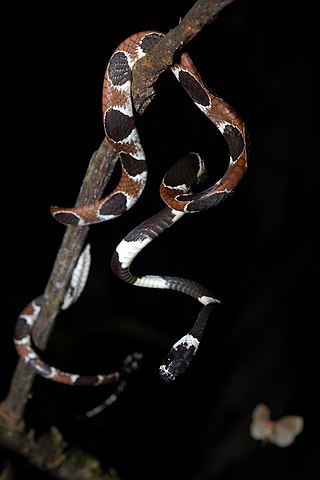
Dipsas variegata, the variegated snail-eater, is a snake found in South America. It is reported to feed almost exclusively on tree snails and slugs.

The Divša Monastery, also known as Đipša (Ђипша), is a Serb Orthodox monastery on the Fruška Gora mountain in the northern Serbian province of Vojvodina. It is believed to have been founded by Despot Jovan Branković in the late 15th century. The earliest historical records about the monastery date to the second half of the 16th century. Owing to Turkish raids, the monastery was deserted in the 17th century; at the beginning of the 18th century, Dipša was mentioned as an appendage of the neighbouring Kuveždin monastery. Its old church underwent reconstruction in 1744, but the final alteration was made in 1762, when a new narthex was built. A chapel dedicated to the Mother of God was placed therein, upstairs. The iconostasis for the restored church was carried out by Teodor Stefanov Gologlavac in 1753.

Dipsas indica, also known as the neotropical snail-eater, is a snake species found in South America. It feeds on slugs and snails, which the snake can extract from their shells using its slender jaw.
The Șieu is a left tributary of the river Someșul Mare in Romania. It discharges into the Someșul Mare near Beclean. Its length is 71 km (44 mi) and its basin size is 1,818 km2 (702 sq mi).

The Lechința is a left tributary of the river Dipșa in Romania. It discharges into the Dipșa near the village Lechința. Its length is 25 km (16 mi) and its basin size is 164 km2 (63 sq mi).
The Dipșa is a left tributary of the river Șieu in Romania. It flows into the Șieu near Chiraleș. Its length is 35 km (22 mi) and its basin size is 459 km2 (177 sq mi).
The Archiud is a left tributary of the river Dipșa in Romania. It flows through the Budurleni Reservoir, and discharges into the Dipșa in the village Dipșa. Its length is 13 km (8.1 mi) and its basin size is 40 km2 (15 sq mi).
The Pintic is a right tributary of the river Dipșa in Romania. It flows into the Dipșa near Teaca. Its length is 16 km (9.9 mi) and its basin size is 52 km2 (20 sq mi).

Endymion, the Man in the Moon is an Elizabethan era comedy by John Lyly, written circa 1588. The action of the play centers around a young courtier, Endymion, who is sent into an endless slumber by Tellus, his former lover, because he has spurned her to worship the ageless Queen Cynthia. The prose is characterised by Euphuism, Lyly's highly ornate, formalised style, meant to convey the intelligence and wit of the speaker. Endymion has been called "without doubt, the boldest in conception and the most beautiful in execution of all Lyly's plays." Lyly makes allusions to ancient Greek and Roman texts and traditional English folklore throughout the play. While the title and characters are references to the myth of Endymion, the plot sharply deviates from the classical story and highlights contemporary issues in Elizabeth I's court through its allegorical framework.
Dipsa is a tiny, mucus-like, extremely venomous snake from Medieval bestiaries. They were so venomous that their victim would die before becoming aware he had been bitten.

Galații Bistriței is a commune in Bistrița-Năsăud County, Transylvania, Romania. It is composed of five villages: Albeștii Bistriței, Dipșa, Galații Bistriței, Herina and Tonciu.

Dipsas is a genus of nonvenomous New World snakes in the subfamily Dipsadinae of the family Colubridae. The genus Sibynomorphus has been moved here. Species of the genus Dipsas are known as snail-eaters.

The graceful snail-eater, is a non-venomous snake found in the northern part of South America . No subspecies are currently recognized.

Catesby's snail-eater, also commonly known as Catesby's snail sucker, is a nocturnal species of nonvenomous snake in the family Colubridae. The species is native to northern South America.

Benjamin Weinreb (1912–1999) was a British bookseller and expert on the history of London who in 1968 sold his entire stock to the University of Texas. He developed a specialism in books about architecture about which his catalogues became important references in themselves.
Dipsas pakaraima is an arboreal snake of the family Dipsadidae. It has been placed in the Dipsas temporalis group. It is native to medium and higher elevations in west-central Guyana. It has been collected in Kaieteur National Park and Mount Ayanganna. Its food probably consists of snails and slugs.

Dipsadinae is a large subfamily of colubroid snakes, sometimes referred to as a family (Dipsadidae). They are found in most of the Americas, including the West Indies, and are most diverse in South America. There are more than 700 species.
Dipsas pratti, known commonly as Pratt's snail-eater, is a species of arboreal snake in the subfamily Dipsadinae of the family Colubridae. The species is endemic to northern South America.

The two-colored snail-eater, is a non-venomous snake found in Honduras, Nicaragua, and Costa Rica.










